 |
 |
|


alternatively
CD: AmazonUK
|
Antonín DVOŘÁK
(1841-1904)
Symphony No. 9 in E minor From the New World, B178 Op.95
(1893) [42:03]
Pyotr Ilyich TCHAIKOVSKY (1840-1893)
Nutcracker Suite Op.71 (1891-92) [21:58]
Johann Sebastian BACH (1685-1750)
Toccata and Fugue in D Minor BWV 565 [9:02]
 Leopold Stokowski and his Symphony Orchestra
Leopold Stokowski and his Symphony Orchestra
rec.1947 (Bach, New World), 34th Street Studios, NYC,
and November 1934, Church Studio No.2, Camden, NJ (Tchaikovsky)
 DUTTON CDBP 9803 [72:23]
DUTTON CDBP 9803 [72:23] 
|
|
|
There are worse things to do than listen to Stokowski’s Dvořák
New World. As admirers of the conductor will know he
had a long running discographic love affair with the symphony.
There were numerous attempts to get things down on disc or tape
over the years. If you’re a real, probably sleepless and obsessive
Stokowskian you will know of the unpublished 1917 acoustic of
the third movement, the 1919 abridged second movement (a 1921
recording of the same was never issued), and then the reduced
band 1925. Soon after that came a 1927 remake, then the famed
1934 - all these with the Philadelphia obviously - and then
the 1940 All American, the one disinterred by Cala and the subject
of this review, and after that recordings with the American
Symphony in 1967 (unpublished) and the 1973 New Philharmonia.
Realistically and sonically we can note that the 1925 early
electric was buffeted by tuba reinforcements and is something
of a trial but the rapid remake two years later was more like
it. It’s a question of taste as to which others you will prefer
- the 1940 All American, 1947 his Symphony Orchestra and the
most pleasingly recorded performance of all (because the latest),
the Philharmonia.
Those with capacious bank accounts might reckon that several
accounts merit archiving. And so in this spirit what of this
1947 recording, made with ‘his’ symphony orchestra, amongst
whose serried ranks sat such luminaries as John Corigliano,
Leonard Rose, Walter Trampler, David Oppenheim and Robert Bloom
- all from the NYPSO in other words; the cor anglais player
was Mitch Miller, whose playing I’m afraid I’ve never much liked
and whose second movement solo here I definitely don’t like,
but I’m in a minority of one on that score.
I’m not sure who was the principal flautist but his oscillatory
vibrato makes something tremulous of the opening statements
of the Symphony. But there’s plenty of bite and power in the
lower strings, a snappy, sappy violin cantilever and plenty
of vertiginous dynamics in the big acoustic of the Manhattan
Center, New York. Similarly big band percussion makes itself
felt and the horns cry with passionate conviction; the winds
have nothing Czech about them at all but there’s much to enjoy
nevertheless. Stokowski’s string cushion in the slow movement
is typically expressive and he’s much slower than, say, Ancerl,
Talich or Reiner. A conventional enough Scherzo follows, though
it has plenty of personality and strength of character before
we reach the finale. This is terse, powerful and toward the
end Stokowski can’t help himself; he sticks in a tam-tam and
reinforced brass and ends in a veritable if dubious blaze of
glory. I’m not going to censure too much, because I did enjoy
it and there are plenty of rectitudinous accounts out there
if you suffer from an allergy to conductorial editing.
Isn’t it disappointing that Stokowski pretty much ignored all
the other symphonies?
The Bach is a familiar 1947 recording, set down in March 1947.
There is tremendous panache and sonority, as one would expect,
and a raft of intensity and grandeur. Recorded thirteen years
earlier, the Tchaikovsky Nutcracker Suite takes us back to Philadelphia
days. He had already set down his first discographic thoughts
with the same orchestral back in 1926 but this later three 78
set provides an even greater sense of aural projection and warmth.
The winds, flutes especially, are on magnificent form, and the
rich sense of rubato Stokowski generates – try the Dance of
the Flutes – is well nigh irresistible. This is a marvellously
alert, vivid reading exploiting every crevice of the orchestra’s
famed virtuosity and sense of individual and corporate colour.
Cala has released the Tchaikovsky [CACD0521 - see review]
and Dvořák recordings [CACD0550 - see review].
The latter was a front-on recording, almost truculently present
and Cala presents it with vivid immediacy, whilst Dutton has
preferred a more interventionist approach, trying to tame some
of its brasher qualities. There is no direct overlap so couplings,
as much as transfer philosophies, may dictate your choice.
Jonathan Woolf
|
|

